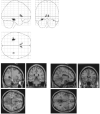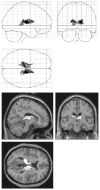On the benefits of not trying: brain activity and connectivity reflecting the interactions of explicit and implicit sequence learning
- PMID: 15537672
- PMCID: PMC3838938
- DOI: 10.1093/cercor/bhh201
On the benefits of not trying: brain activity and connectivity reflecting the interactions of explicit and implicit sequence learning
Abstract
Under certain circumstances, implicit, automatic learning may be attenuated by explicit memory processes. We explored the brain basis of this phenomenon in a functional magnetic resonance imaging (fMRI) study of motor sequence learning. Using a factorial design that crossed subjective intention to learn (explicit versus implicit) with sequence difficulty (a standard versus a more complex alternating sequence), we show that explicit attempts to learn the difficult sequence produce a failure of implicit learning and, in a follow-up behavioural experiment, that this failure represents a suppression of learning itself rather than of the expression of learning. This suppression is associated with sustained right frontal activation and attenuation of learning-related changes in the medial temporal lobe and the thalamus. Furthermore, this condition is characterized by a reversal of the fronto-thalamic connectivity observed with unimpaired implicit learning. The findings demonstrate a neural basis for a well-known behavioural effect: the deleterious impact of an explicit search upon implicit learning.
Figures







References
-
- Aizenstein HJ, Stenger VA, Cochran J, Clark K, Johnson M, Nebes RD, Carter CS. Regional brain activation during concurrent implicit and explicit sequence learning. Cereb Cortex. 2004;14:199–208. - PubMed
-
- Benjamini Y, Hochberg Y. Controlling the false discovery rate: a practical and powerful approach to multiple testing. J R Statist Soc B. 1995;57:289–300.
-
- Bey C, Zatorre RJ. Recognition of interleaved melodies. An fMRI study. Ann N Y Acad Sci. 2003;999:152–154. - PubMed
Publication types
MeSH terms
Grants and funding
LinkOut - more resources
Full Text Sources
Medical

